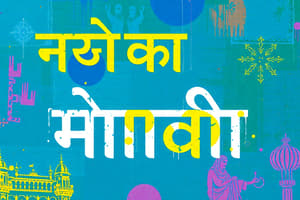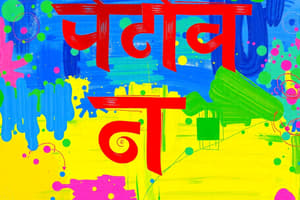Podcast
Questions and Answers
In Hindi grammar, nouns are inflected for:
In Hindi grammar, nouns are inflected for:
- Case and person
- Tense and aspect
- Mood and voice
- Gender and number (correct)
Which of the following is a characteristic of Hindustani?
Which of the following is a characteristic of Hindustani?
- Extensive case marking
- Complex verb conjugations
- Exclusively Sanskrit-derived vocabulary
- Simplified grammar (correct)
Modern Standard Hindi was standardized in which century?
Modern Standard Hindi was standardized in which century?
- 20th century (correct)
- 21st century
- 18th century
- 19th century
Knowledge of Hindi can be valuable for those interested in:
Knowledge of Hindi can be valuable for those interested in:
Which of these English words is of Hindi origin?
Which of these English words is of Hindi origin?
Which language family does Hindi originate from?
Which language family does Hindi originate from?
What is the immediate ancestor of Hindi considered to be?
What is the immediate ancestor of Hindi considered to be?
According to the Indian Constitution, what script is Hindi written in when used as the official language?
According to the Indian Constitution, what script is Hindi written in when used as the official language?
Which of the following is a dialect of Hindi?
Which of the following is a dialect of Hindi?
Which of these countries has a significant Hindi-speaking population due to the Indian diaspora?
Which of these countries has a significant Hindi-speaking population due to the Indian diaspora?
Modern Standard Hindi evolved primarily from which dialect?
Modern Standard Hindi evolved primarily from which dialect?
Which language significantly influenced the development of Hindi during the Delhi Sultanate and Mughal Empire?
Which language significantly influenced the development of Hindi during the Delhi Sultanate and Mughal Empire?
In Hindi grammar, how are the elements in a sentence typically ordered?
In Hindi grammar, how are the elements in a sentence typically ordered?
Flashcards
Verb Conjugation
Verb Conjugation
A system where verbs change form to indicate tense, aspect, mood, gender, and number.
Noun Inflection in Hindi
Noun Inflection in Hindi
The inflection of nouns to indicate masculine and feminine forms, as well as singular and plural.
Hindustani
Hindustani
A colloquial form of Hindi-Urdu with simplified grammar, drawing vocab from Sanskrit, Persian, & Arabic
Modern Standard Hindi
Modern Standard Hindi
Signup and view all the flashcards
Hindi Loanwords in English
Hindi Loanwords in English
Signup and view all the flashcards
What is Hindi?
What is Hindi?
Signup and view all the flashcards
Hindi's Origin
Hindi's Origin
Signup and view all the flashcards
Official Status of Hindi
Official Status of Hindi
Signup and view all the flashcards
Where is Hindi Spoken?
Where is Hindi Spoken?
Signup and view all the flashcards
Dialects of Hindi
Dialects of Hindi
Signup and view all the flashcards
Hindi Writing System
Hindi Writing System
Signup and view all the flashcards
Hindi Vocabulary Sources
Hindi Vocabulary Sources
Signup and view all the flashcards
Hindi Grammar Basics
Hindi Grammar Basics
Signup and view all the flashcards
Study Notes
- Hindi is an Indo-Aryan language primarily spoken in India.
- It is the official language of the Union government of India, along with English.
- Hindi serves as the lingua franca of the Hindi belt.
Origin and History
- The roots of Hindi can be traced back to the ancient Indo-European language family.
- Hindi evolved from Sanskrit through Prakrit and Apabhramsa.
- Shauraseni Apabhramsa is considered the immediate ancestor of Hindi.
- Modern Standard Hindi evolved mainly from the Khariboli dialect of Delhi and its surrounding areas.
- During the Delhi Sultanate and Mughal Empire, Persian significantly influenced Hindi's development, leading to Hindustani, a blend of Hindi and Persian.
Official Status
- Hindi is one of the 22 scheduled languages of India.
- Article 343(1) of the Constitution specifies that the official language of the Union is Hindi in the Devanagari script.
- English is also used as an additional official language.
- Hindi is the official language of several states in India, including Uttar Pradesh, Himachal Pradesh, Delhi, Haryana, Bihar, Jharkhand, Madhya Pradesh, Chhattisgarh, and Rajasthan.
Geographical Distribution
- Hindi is mainly spoken in the Hindi Belt of India.
- Significant Hindi-speaking populations exist in other parts of India and countries with large Indian diasporas, such as Nepal, Fiji, Mauritius, South Africa, Suriname, Trinidad and Tobago, and Guyana.
Dialects
- Hindi is not monolithic and includes multiple dialects and variations.
- Major dialects include Awadhi, Braj Bhasha, Bundeli, Bagheli, Bhojpuri, Haryanvi, and Rajasthani.
- Some linguists consider many of these dialects separate languages.
- Khariboli serves as the basis for Modern Standard Hindi.
Writing System
- Hindi is written in the Devanagari script.
- Devanagari is an abugida, where each consonant has an inherent vowel (typically /a/), which can be modified or suppressed using vowel marks.
- The script is written from left to right.
- It is also used for other languages like Sanskrit, Marathi, and Nepali.
Vocabulary
- Hindi's vocabulary primarily comes from Sanskrit and Prakrit.
- It has also borrowed words from Persian, Arabic, Turkish, and English.
- The degree of Sanskritization in Hindi varies, with some speakers using more Sanskritized forms and others using more colloquial Hindustani forms.
Grammar
- Hindi follows an SOV (subject-object-verb) sentence structure.
- It uses postpositions rather than prepositions.
- Hindi has a relatively complex system of verb conjugations, marked by tense, aspect, mood, gender, and number.
- Nouns are inflected for gender (masculine and feminine) and number (singular and plural), affecting agreement with adjectives and verbs.
- Hindi features a system of case marking, although its use is diminishing among some speakers.
Influence of Hindustani
- Hindustani is a colloquial register of Hindi-Urdu that emerged during the Delhi Sultanate.
- It is characterized by simplified grammar and vocabulary that draws from Sanskrit, Persian, and Arabic-derived words.
- Bollywood films and popular culture often use Hindustani, contributing to its widespread understanding across the Indian subcontinent and diaspora.
Standardization
- Modern Standard Hindi was standardized in the 20th century.
- Bharatendu Harishchandra played a significant role in popularizing Khariboli-based Hindi in literature.
- Various governmental and non-governmental organizations have made efforts to promote and propagate Hindi.
Learning Hindi
- Hindi is taught as a second language in many schools in India.
- Resources are available for learning Hindi, including textbooks, online courses, and language exchange programs.
- Knowledge of Hindi is valuable for those interested in Indian culture, literature, and Bollywood cinema.
Loanwords in English
- Many words of Hindi origin have been adopted into the English language.
- Examples include 'shampoo' (from champo), 'jungle' (from jangal), 'bungalow' (from bangla), 'avatar' (from avatāra), 'guru' (from guru), 'karma' (from karma), and 'pajamas' (from pajama).
Studying That Suits You
Use AI to generate personalized quizzes and flashcards to suit your learning preferences.




